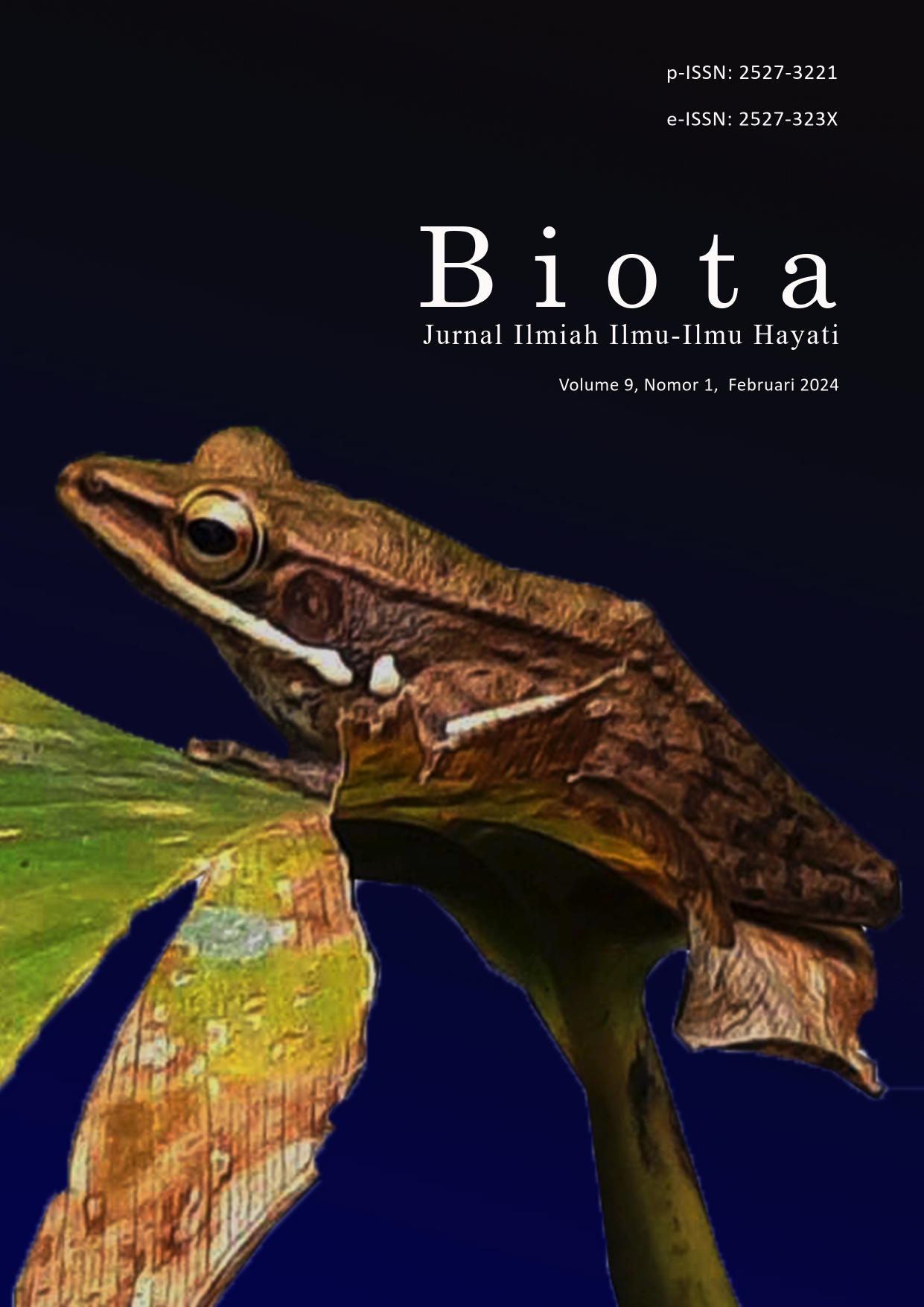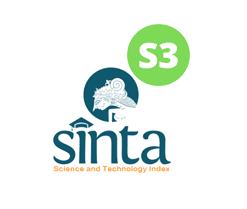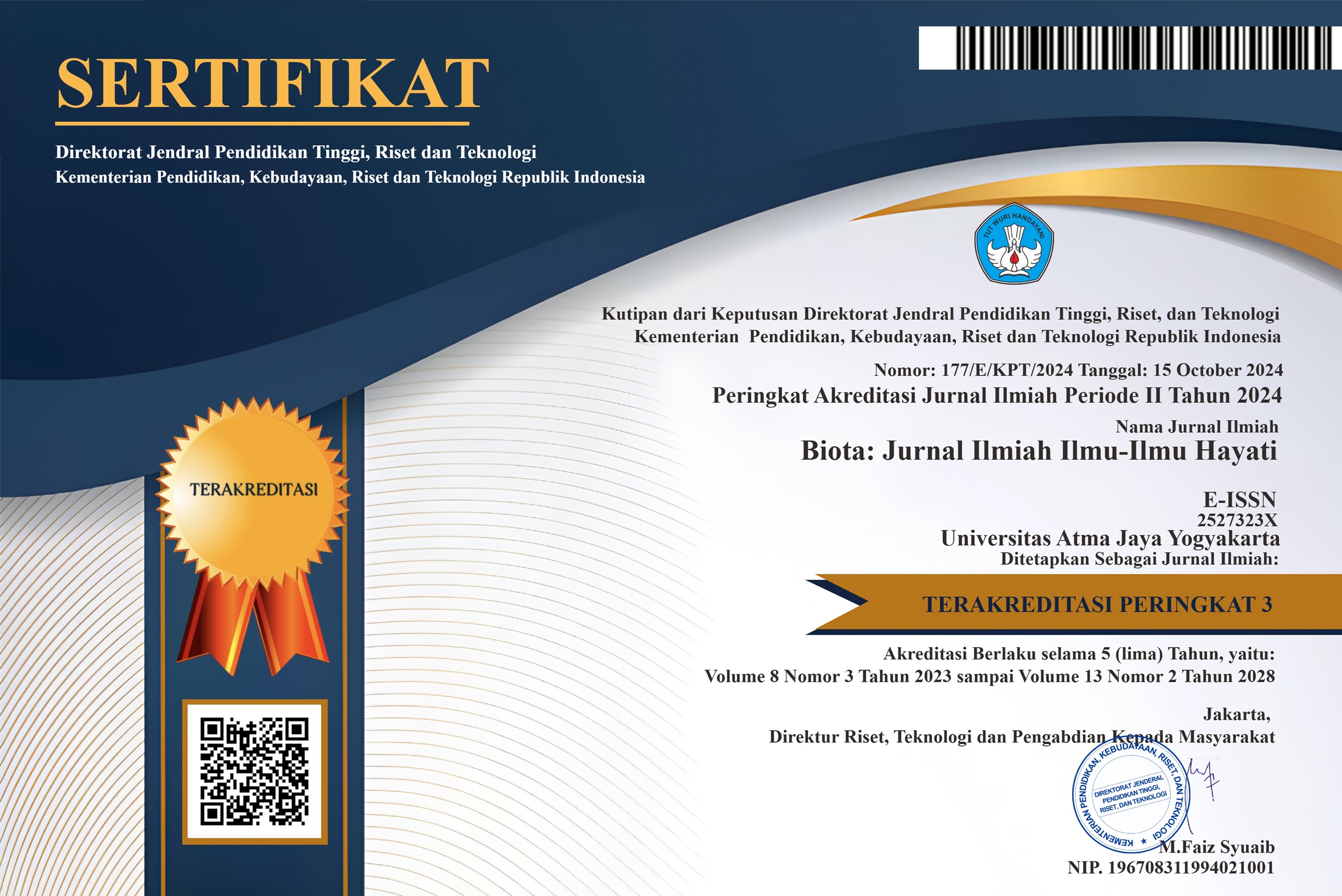Paparan Pestisida Menginduksi Senesen Dini pada Mesenchymal Stem Cell In Vitro
DOI:
https://doi.org/10.24002/biota.v9i1.6340Keywords:
in vitro, MSCs, pestisida, sel punca, senesenAbstract
Pestisida merupakan senyawa kimia yang banyak digunakan sebagai pengendali hama pada aktivitas pertanian. Residu penggunaan pestisida ini dapat mengakibatkan polusi pada lingkungan perairan khususnya di sekitar lahan pertanian. Pestisida yang terakumulasi pada lingkungan perairan maupun hasil pertanian memberikan dampak buruk bagi manusia antara lain gangguan pada sistem organ, jaringan, perkembangan, dan pada tingkat sel mengarah ke senesen. Senesen merupakan suatu kondisi saat sel berhenti melakukan proliferasi. Sel yang mengalami senesen secara alami umumnya terjadi pada individu tua, sebagai respons terhadap pemendekan telomer. Senesen dini akibat paparan pestisida pada umumnya melibatkan mekanisme stres oksidatif, kerusakan DNA, dan disfungsi mitokondria. Senesen memicu penurunan fungsi organ yang mengakibatkan berbagai masalah kesehatan seperti kanker, osteoporosis, penyakit kardiovaskuler hingga demensia. Selain itu, senesen juga dapat menyebabkan berhentinya siklus sel punca antara lain pada mesenchymal stem cells (MSCs). Ulasan ini fokus membahas mekanisme senesen akibat paparan pestisida pada sel punca terutama MSCs. Metode yang digunakan yaitu koleksi data dan analisis dari jurnal terindeks Scopus dengan menggunakan VOSviewer. Berdasarkan hasil ulasan diketahui bahwa pestisida menginduksi senesen pada MSCs melalui jaras peningkatan konsentrasi ROS dalam sel dan penurunan aktivitas ALDH. Hal tersebut menyebabkan aktivasi p53, dan p21, yang kemudian akan menyebabkan hambatan pada CDK2 dan pRB, berakibat pada inaktivasi E2F serta induksi senesen. Senesen juga akan memberikan respons patofisiologis lain hingga efek tumorigenesis.
References
Akter, R., Pervin, M. A., Jahan, H., Rakhi, S. F., Reza, A. H. M. M., & Hossain, Z. (2020). Toxic effects of an organophosphate pesticide, envoy 50 SC on the histopathological, hematological, and brain acetylcholinesterase activities in stinging catfish (Heteropneustes fossilis). The Journal of Basic and Applied Zoology 81(47): 1-14.
Alengebawy, A., Abdelkhalek, S. T., Qureshi, S. R., & Wang, M.-Q. (2021). Heavy metals and pesticides toxicity in agricultural soil and plants: Ecological risks and human health implications. Toxics 9(42): 1-33.
Al-Jabi, S. W. (2017). Global research trends in West Nile virus from 1943 to 2016: A bibliometric analysis. Globalization and Health 13(55): 1-9.
Al-Jezani, N., Cho, R., Masson, A. O., Lenehan, B., Krawetz, R., & Lyons, F. G. (2019). Isolation and characterization of an adult stem cell population from Human epidural fat. Stem Cells International 2019: 1–12.
Amilia, E., Joy, B., & Sunardi, S. (2016). Residu pestisida pada tanaman hortikultura (studi kasus di Desa Cihanjuang Rahayu Kecamatan Parongpong Kabupaten Bandung Barat). Agrikultura 27(1): 23–29.
An, Y. (2020). Detection of pesticide residues in soil, water, and food. IOP Conference Series: Earth and Environmental Science 544(2020): 1–7.
Andreotti, G., Hoppin, J. A., Hou, L., Koutros, S., Gadalla, S. M., Savage, S. A., Lubin, J., Blair, A., Hoxha, M., Baccarelli, A., Sandler, D., Alavanja, M., & Beane Freeman, L. E. (2015). Pesticide use and relative leukocyte telomere length in the agricultural health study. PLOS ONE 10(7): e0133382.
Ardiwinata, A. N. (2020). Pemanfaatan arang aktif dalam pengendalian residu pestisida di tanah: Prospek dan masalahnya. Jurnal Sumberdaya Lahan 14(1): 49–62.
Badan Pusat Statistik. (2021). Produksi padi tahun 2021 naik 1,14 persen (angka sementara). https://www.bps.go.id/pressrelease/2021/10/15/1850/produksi-padi-tahun-2021-naik-1-14-persen-angka-sementara-.html
Barnes, P. J., Baker, J., & Donnelly, L. E. (2019). Cellular senescence as a mechanism and target in chronic lung diseases. American Journal of Respiratory and Critical Care Medicine 200(5): 556–564.
Beltrami, A. P., Barlucchi, L., Torella, D., Baker, M., Limana, F., Chimenti, S., Kasahara, H., Rota, M., Musso, E., Urbanek, K., Leri, A., Kajstura, J., Nadal-Ginard, B., & Anversa, P. (2003). Adult cardiac stem cells are multipotent and support myocardial regeneration. Cell 114(6): 763–776.
Boulestreau, J., Maumus, M., Rozier, P., Jorgensen, C., & Noël, D. (2020). Mesenchymal stem cell derived extracellular vesicles in aging. Frontiers in Cell and Developmental Biology 8(107): 1–9.
Caplan, A. I. (2017). Mesenchymal stem cells: Time to change the name! Stem Cells Translational Medicine 6(6): 1445–1451.
Collado, M., Blasco, M. A., & Serrano, M. (2007). Cellular senescence in cancer and aging. Cell 130(2): 223–233.
Colle, D., Farina, M., Ceccatelli, S., & Raciti, M. (2018). Paraquat and maneb exposure alters rat neural stem cell proliferation by inducing oxidative stress: New insights on pesticide-induced neurodevelopmental toxicity. Neurotoxicity Research 34(4): 820–833.
Díaz-Resendiz, K. J. G., Ortiz-Lazareno, P. C., Covantes-Rosales, C. E., Trujillo-Lepe, A. M., Toledo-Ibarra, G. A., Ventura-Ramón, G. H., & Girón-Pérez, M. I. (2019). Effect of diazinon, an organophosphate pesticide, on signal transduction and death induction in mononuclear cells of Nile tilapia fish (Oreochromis niloticus). Fish & Shellfish Immunology 89: 12–17.
DiBattista, A. M., Sierra, F., & Masliah, E. (2020). NIA workshop on senescence in brain aging and alzheimer’s disease and its related dementias. GeroScience 42(2): 389–396.
Domínguez-Bendala, J., Lanzoni, G., Inverardi, L., & Ricordi, C. (2012). Concise review: Mesenchymal stem cells for diabetes. Stem Cells Translational Medicine 1(1): 59–63.
Fernández, L. (2021). Top pesticide consuming countries worldwide. Statista. https://www.statista.com/statistics/1263069/global-pesticide-use-by-country/.
Fitriadi, B. R., & Putri, A. C. (2019). Dampak pplikasi pestisida sipermetrin, deltametrin, klorpirifos dan λ-sihalotrin terhadap kandungan residu pestisida pada biji kakao. Jurnal Agrosains dan Teknologi 4(1): 10-18.
Fleury, H., Malaquin, N., Tu, V., Gilbert, S., Martinez, A., Olivier, M.-A., Sauriol, A., Communal, L., Leclerc-Desaulniers, K., Carmona, E., Provencher, D., Mes-Masson, A.-M., & Rodier, F. (2019). Exploiting interconnected synthetic lethal interactions between PARP inhibition and cancer cell reversible senescence. Nature Communications 10(1): 1–15.
Foucault, A., Ravalet, N., Besombes, J., Picou, F., Gallay, N., Babin, L., Bourgeais, J., Hamard, S., Domenech, J., Loyer, P., Vallet, N., Lejeune, J., Gyan, E., Béné, M. C., Vallette, F., Olivier, C., & Hérault, O. (2021). Low-Dose pesticides alter primary human bone marrow mesenchymal stem/stromal cells through ALDH2 inhibition. Cancers 13(22): 5699.
Harsanti, S. E., Martono, E., Sudibyakto, H. A., & Sugiharto, E. (2015). Residu insektisida klorpirifos dalam tanah dan produk bawang merah Allium ascalonicum L, di sentra produksi bawang merah di Kabupaten Bantul, Yogyakarta. Jurnal Ecolab 9(1): 26–35.
Hayflick, L., & Moorhead, P. S. (1961). The serial cultivation of human diploid cell strains. Experimental Cell Research 25(3): 585–621.
Hochane, M., Trichet, V., Pecqueur, C., Avril, P., Oliver, L., Denis, J., Brion, R., Amiaud, J., Pineau, A., Naveilhan, P., Heymann, D., Vallette, F. M., & Olivier, C. (2017). Low‐dose pesticide mixture induces senescence in normal mesenchymal stem cells (MSC) and promotes tumorigenic phenotype in premalignant MSC. Stem Cells 35(3): 800–811.
Ilboudo, S., Fouche, E., Rizzati, V., Toé, A. M., Gamet-Payrastre, L., & Guissou, P. I. (2014). In vitro impact of five pesticides alone or in combination on human intestinal cell line Caco-2. Toxicology Reports 1: 474–489.
Jacobs, A. T., & Marnett, L. J. (2010). Systems analysis of protein modification and cellular responses induced by electrophile stress. Accounts of Chemical Research 43(5): 673–683.
Kahl, V. F. S., Dhillon, V., Fenech, M., de Souza, M. R., da Silva, F. N., Marroni, N. A. P., Nunes, E. A., Cerchiaro, G., Pedron, T., Batista, B. L., Cappetta, M., Mártinez-López, W., Simon, D., & da Silva, J. (2018). Occupational exposure to pesticides in tobacco fields: The integrated evaluation of nutritional intake and susceptibility on genomic and epigenetic instability. Oxidative Medicine and Cellular Longevity 2018: 1–13.
Kaur, K. & Kaur, R. (2018). Occupational pesticide exposure, impaired DNA repair, and diseases. Indian Journal of Occupational and Environmental Medicine 22(2): 74.
Kementerian Pertanian. (2021). Keputusan menteri pertanian republik indonesia No. 29I/KPTS/SR.330/M/2021 Pemberian nomor pendaftaran dan izin tetap bahan teknis. http://pvtpp.setjen.pertanian.go.id/cms2017/wpcontent/uploads/2021/10/599_Kpts_SR.330_M_10_2021-Pemberian-Nomor-Pendaftaran-dan-Izin-Tetap-Bahan-Teknis-Pestisida.pdf.
Kern, S., Eichler, H., Stoeve, J., Klüter, H., & Bieback, K. (2006). Comparative analysis of mesenchymal stem cells from bone marrow, umbilical cord blood, or adipose tissue. Stem Cells 24(5): 1294–1301.
Kuilman, T., Michaloglou, C., Mooi, W. J., & Peeper, D. S. (2010). The essence of senescence. Genes & Development 24: 2463–2479.
Kumari, R., & Jat, P. (2021). Mechanisms of cellular senescence: Cell cycle arrest and senescence associated secretory phenotype. Frontiers in Cell and Developmental Biology 9: 1–24.
Lanzoni, G., Alviano, F., Marchionni, C., Bonsi, L., Costa, R., Foroni, L., Roda, G., Belluzzi, A., Caponi, A., Ricci, F., Luigi Tazzari, P., Pagliaro, P., Rizzo, R., Lanza, F., Roberto Baricordi, O., Pasquinelli, G., Roda, E., & Paolo Bagnara, G. (2009). Isolation of stem cell populations with trophic and immunoregulatory functions from human intestinal tissues: Potential for cell therapy in inflammatory bowel disease. Cytotherapy 11(8): 1020–1031.
Lee, O. K., Kuo, T. K., Chen, W.-M., Lee, K.-D., Hsieh, S.-L., & Chen, T.-H. (2004). Isolation of multipotent mesenchymal stem cells from umbilical cord blood. Blood 103(5): 1669–1675.
Leveque, X., Hochane, M., Geraldo, F., Dumont, S., Gratas, C., Oliver, L., Gaignier, C., Trichet, V., Layrolle, P., Heymann, D., Herault, O., Vallette, F. M., & Olivier, C. (2019). Low-dose pesticide mixture induces accelerated mesenchymal stem cell aging in vitro. Stem Cells 37(8): 1083–1094.
Marei, H. E., Hasan, A., Rizzi, R., Althani, A., Afifi, N., Cenciarelli, C., Caceci, T., & Shuaib, A. (2018). Potential of stem cell-based therapy for ischemic stroke. Frontiers in Neurology 9: 34.
McHugh, D., & Gil, J. (2018). Senescence and aging: Causes, consequences, and therapeutic avenues. Journal of Cell Biology 217(1): 65–77.
Mo, J., Xia, Y., Ning, Z., Wade, T. J., & Mumford, J. L. (2009). Elevated Human Telomerase Reverse Transcriptase Gene Expression in Blood Cells Associated with Chronic Arsenic Exposure in Inner Mongolia, China. Environmental Health Perspectives 117(3): 354–360.
Moser, V. C., Phillips, P. M., & McDaniel, K. L. (2015). Assessment of biochemical and behavioral effects of carbaryl and methomyl in Brown-Norway rats from preweaning to senescence. Toxicology 331: 1–13.
Nining, E., Nazli, R. S. S., Mas’ud, Z. A., Machfud, & Sobir. (2019). Profil residu insektisida organofosfat di kawasan produksi bawang merah (Allium ascalonicum L.) Kabupaten Brebes Jawa Tengah. Journal of Natural Resources and Environmental Management 9(4): 999–1009.
Nugroho, B. Y. H., Wulandari, S. Y., & Ridlo, A. (2015). Analisis residu pestisida organofosfat di Perairan Mlonggo Kabupaten Jepara. Journal of Oceanography 4(3): 541–544.
Papaconstantinou, J. (2019). The role of signaling pathways of inflammation and oxidative stress in development of senescence and aging phenotypes in cardiovascular disease. Cells 8(11): 1383.
Parmar, M., Grealish, S., & Henchcliffe, C. (2020). The future of stem cell therapies for Parkinson disease. Nature Reviews Neuroscience 21(2): 103-115.
Pignolo, R. J., Law, S. F., & Chandra, A. (2021). Bone Aging, Cellular Senescence, and Osteoporosis. JBMR Plus 5(4): e10488.
Pratama, D. A. O., Aulia, Z., Aulanni’am, A., & Permata, F. S. (2019). The study of organophosphate (diazinon) toxicity toward liver histopathology and malondialdehyde (MDA) serum levels on rats (Rattus norvegicus). Veterinary Biomedical and Clinical Journal 1(2): 15–23.
Rackova, L., Mach, M., & Brnoliakova, Z. (2021). An update in toxicology of ageing. Environmental Toxicology and Pharmacology 84: 103611.
Raggi, C., & Berardi, A. C. (2012). Mesenchymal stem cells, aging and regenerative medicine. Muscles, Ligaments and Tendons Journal 2(3): 239–242.
Ranjbar-Sahraei, B., & Negenborn, R. R. (2017). Research positioning and trend identification: A data-analytics toolbox. http://aida.tudelft.nl/toolbox/aida-booklet.
Rotter, N., Oder, J., Schlenke, P., Lindner, U., Böhrnsen, F., Kramer, J., Rohwedel, J., Huss, R., Brandau, S., Wollenberg, B., & Lang, S. (2008). Isolation and characterization of adult stem cells from human salivary glands. Stem Cells and Development 17(3): 509–518.
Saftrina, F., Sari, R. P., & Sutarto. (2018). Pengaruh paparan pestisida pada masa kehamilan terhadap perkembangan anak. Jurnal Kedokteran Universitas Lampung 2(1): 63–67.
Salama, R., Sadaie, M., Hoare, M., & Narita, M. (2014). Cellular senescence and its effector programs. Genes & Development 28(2): 99–114.
Sandoval-Herrera, N., Mena, F., Espinoza, M., & Romero, A. (2019). Neurotoxicity of organophosphate pesticides could reduce the ability of fish to escape predation under low doses of exposure. Scientific Reports 9(1): 10530.
Santos, C., Fragoeiro, S., Oliveira, H., & Phillips, A. (2006). Response of Vitis vinifera L. plants inoculated with Phaeoacremonium angustius and Phaeomoniella chlamydospora to thiabendazole, resveratrol and sodium arsenite. Scientia Horticulturae 107(2): 131–136.
Satyanarayana, A., Manns, M. P., & Rudolph, K. L. (2004). Telomeres and telomerase: A dual role in hepatocarcinogenesis. Hepatology 40(2): 276–283.
Shaw, S., & Jayatilleke, E. (1987). Acetaldehyde-mediated hepatic lipid peroxidation: Role of superoxide and ferritin. Biochemical and Biophysical Research Communications 143(3): 984–990.
Silva Kahl, V. F., Hilário Garcia, A. L., de Souza, M. R., Dalberto, D., Bento De Oliveira, A. F., & Da Silva, J. (2019). Biomarkers of early effects for occupational exposure. In Occupational Stress: Risk Factors, Prevention and Management Strategies. Scopus.
Singh, S., Brocker, C., Koppaka, V., Ying, C., Jackson, B., Matsumoto, A., Thompson, D. C., & Vasiliou, V. (2013). Aldehyde dehydrogenases in cellular responses to oxidative/electrophilic stress. Free Radical Biology & Medicine 56: 89–101.
Song, Z., Von Figura, G., Liu, Y., Kraus, J. M., Torrice, C., Dillon, P., Rudolph-Watabe, M., Ju, Z., Kestler, H. A., Sanoff, H., & Lenhard Rudolph, K. (2010). Lifestyle impacts on the aging-associated expression of biomarkers of DNA damage and telomere dysfunction in human blood: Measuring the influence of lifestyle on aging. Aging Cell 9(4): 607–615.
Sumiati, A., & Julianto, R. P. D. (2017). Analisis residu pestisida pada jeruk manis di Kecamatan Dau, Malang. Buana Sains 17(1): 19-24
Sun, N., Youle, R. J., & Finkel, T. (2016). The mitochondrial basis of aging. Molecular Cell 61(5): 654–666.
Takubo, K., Nakamura, K.-I., Izumiyama, N., Furugori, E., Sawabe, M., Arai, T., Esaki, Y., Mafune, K.-I., Kammori, M., Fujiwara, M., Kato, M., Oshimura, M., & Sasajima, K. (2000). Telomere shortening with aging in human liver. The Journals of Gerontology Series A: Biological Sciences and Medical Sciences 55(11): 533–536.
Tanabe, S. (2014). Role of mesenchymal stem cells in cell life and their signaling. World Journal of Stem Cells 6(1): 24-32.
Téllez-Bañuelos, M. C., González-Ochoa, S., Ortiz-Lazareno, P. C., Rosas-Gonzalez, V. C., Gómez-Villela, J., & Haramati, J. (2019). Low-dose endosulfan inhibits proliferation and induces senescence and pro-inflammatory cytokine production in human lymphocytes, preferentially impacting cytotoxic cells. Journal of Immunotoxicology 16(1): 173–181.
Vasiliou, V., Pappa, A., & Estey, T. (2004). Role of human aldehyde dehydrogenases in endobiotic and xenobiotic metabolism. Drug Metabolism Reviews 36(2): 279–299.
Wariki, W. C., Siahaan, R., & Rumondor, M. (2015). Analisis kualitiatif residu pestisida profenofos pada tanaman tomat di Kecamatan Langowan Barat Sulawesi Utara. Jurnal Ilmiah Sains 15(1): 48-51.
Zaenab, Z. (2018). Identifikasi residu pestisida chlorpyrifos dalam sayuran sawi hijau (Brassica rapa var. Parachinensis L.) di pasar terong Kota Makassar. Media Kesehatan Politeknik Kesehatan Makassar, 11(2): 52-59.
Zaganas, I., Kapetanaki, S., Mastorodemos, V., Kanavouras, K., Colosio, C., Wilks, M. F., & Tsatsakis, A. M. (2013). Linking pesticide exposure and dementia: What is the evidence? Toxicology 307(2013): 3–11.
Zhang, C.-L., Huang, T., Wu, B.-L., He, W.-X., & Liu, D. (2017). Stem cells in cancer therapy: Opportunities and challenges. Oncotarget 8(43): 75756–75766.
Downloads
Published
How to Cite
Issue
Section
License
Copyright (c) 2024 Ascarti Adaninggar, Galuh Oktavya, Raden Roro Risang Ayu Dewayani Putri, Suci Hari Utami Aprilianti, Ardaning Nuriliani

This work is licensed under a Creative Commons Attribution-NonCommercial 4.0 International License.
Authors who publish with Biota : Jurnal Ilmiah Ilmu-Ilmu Hayati agree to the following terms:
- Authors retain copyright and grant the Biota : Jurnal Ilmiah Ilmu-Ilmu Hayati right of first publication. Licensed under a Creative Commons Attribution-NonCommercial 4.0 International License that allows others to share the work with an acknowledgment of the work's authorship and initial publication in this journal.
- Authors are able to enter into separate, additional contractual arrangements for the non-exclusive distribution of the journal's published version of the work (e.g., post it to an institutional repository or publish it in a book), with an acknowledgment of its initial publication in Biota : Jurnal Ilmiah Ilmu-Ilmu Hayati, and as long as Author is not used for commercial purposes.













